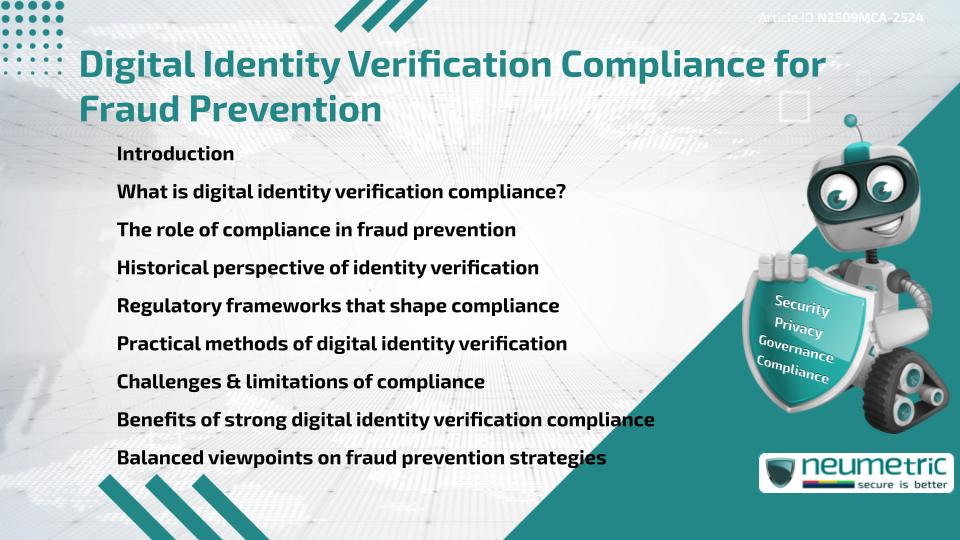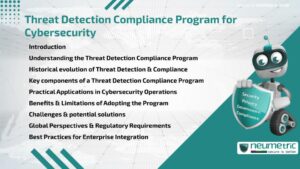Table of Contents
ToggleIntroduction
Digital identity verification compliance is central to building trust in the digital economy. It ensures that businesses validate Customer identities according to strict Regulatory Standards, helping prevent fraud, money laundering & unauthorized access. By aligning with legal requirements, companies protect both Customers & themselves from Financial losses. This article explores what digital identity verification compliance means, why it matters for fraud prevention, how it has evolved, its challenges & the benefits it brings.
What is digital identity verification compliance?
Digital identity verification compliance refers to the adherence of businesses & institutions to regulations that govern how Customer identities are verified online. It ensures that the process of confirming a person’s identity meets legal, technical & Ethical Standards. Without such compliance, companies Risk hefty penalties, reputational damage & exposure to fraudulent activity.
The role of compliance in fraud prevention
Fraud thrives in environments where Customer identities are poorly validated. By ensuring digital identity verification compliance, Organisations can reduce Risks of impersonation, account takeover & illegal transactions. Compliance frameworks often require a layered approach, including document verification, biometric checks & ongoing monitoring. These practices help prevent fraud before it occurs rather than only responding afterward.
Historical perspective of identity verification
In the past, identity verification relied heavily on physical documents like passports, driver’s licenses & utility bills. Banks & institutions conducted in-person checks, which made fraud more difficult but also slowed down services. With the rise of online transactions, these traditional methods became less effective. The digital shift created opportunities for fraudsters, prompting regulators to introduce standards for digital identity verification compliance that mimic & improve upon traditional methods.
Regulatory frameworks that shape compliance
Several laws & frameworks dictate how businesses must approach digital identity verification compliance. For example, the General Data Protection Regulation (GDPR) in Europe enforces strict Data Protection rules, while the Know your Customer (KYC) and Anti-Money Laundering (AML) standards set requirements for verifying identities in Financial services. In the United States, regulations such as the Bank Secrecy Act enforce similar obligations. Together, these frameworks ensure businesses have consistent, legally backed processes for fraud prevention.
Practical methods of digital identity verification
Compliance in practice often involves a mix of technologies & procedures. Document scanning with machine learning can validate IDs in seconds. Biometric verification, such as fingerprint & facial recognition, adds another layer of security. Multi-factor authentication links identity verification to device ownership or physical tokens. Continuous Monitoring of account activity ensures suspicious behavior is flagged early. These methods collectively strengthen compliance & make fraud more difficult to execute.
Challenges & limitations of compliance
Despite its importance, digital identity verification compliance faces challenges. Privacy concerns remain significant, as Customers may fear misuse of Sensitive Data. Technical limitations, such as errors in biometric recognition, can also create friction for legitimate users. Moreover, compliance can be costly for smaller businesses that lack resources to implement sophisticated systems. Critics argue that over-reliance on compliance frameworks may encourage a “checklist mentality” rather than genuine fraud prevention.
Benefits of strong digital identity verification compliance
When done properly, digital identity verification compliance offers multiple benefits. Businesses gain protection from fraud-related Financial losses & build Customer Trust by demonstrating security. Compliance also reduces regulatory Risk, shielding Organisations from fines or sanctions. Importantly, it creates a safer digital ecosystem, enabling Customers to engage in online transactions with confidence.
Balanced viewpoints on fraud prevention strategies
Some experts argue that compliance alone cannot prevent fraud. They stress that human vigilance, Cybersecurity education & cross-industry collaboration are equally important. Others contend that compliance forms the backbone of any fraud prevention strategy, without which efforts become fragmented. A balanced approach acknowledges that while compliance is crucial, it should be complemented by innovation, awareness & adaptability.
Conclusion
Digital identity verification compliance plays a vital role in protecting individuals & businesses from fraud. It transforms identity validation into a reliable, standardised & secure process. While not without challenges, compliance frameworks establish trust & accountability in digital interactions.
Takeaways
- Digital identity verification compliance reduces fraud Risks by enforcing standardised processes.
- Regulatory frameworks like GDPR, KYC, AML & the Bank Secrecy Act shape Compliance Requirements.
- Practical methods include biometric checks, document scanning & multi-factor authentication.
- Compliance is not a silver bullet but is an essential pillar of fraud prevention.
FAQ
What is the purpose of digital identity verification compliance?
It ensures that businesses follow regulations when verifying Customer identities to reduce fraud & maintain trust.
How does compliance prevent fraud?
It prevents fraud by requiring robust identity checks that make impersonation & account takeovers more difficult.
Which industries rely most on digital identity verification compliance?
Financial services, Healthcare & e-commerce rely heavily on compliance to secure transactions & Customer Data.
What are the challenges of compliance?
Challenges include Privacy concerns, technical errors in biometric systems & the high cost of implementation for small firms.
Is compliance mandatory in all countries?
No, but most regions have some form of Regulation such as GDPR in Europe or KYC & AML requirements globally.
How is compliance different from basic verification?
Basic verification checks identity at a surface level, while compliance ensures the process meets regulatory & legal standards.
Can compliance eliminate fraud completely?
No, but it significantly reduces Risks. Fraud prevention also depends on awareness, monitoring & broader Security Measures.
Need help for Security, Privacy, Governance & VAPT?
Neumetric provides organisations the necessary help to achieve their Cybersecurity, Compliance, Governance, Privacy, Certifications & Pentesting needs.
Organisations & Businesses, specifically those which provide SaaS & AI Solutions in the Fintech, BFSI & other regulated sectors, usually need a Cybersecurity Partner for meeting & maintaining the ongoing Security & Privacy needs & requirements of their Enterprise Clients & Privacy conscious Customers.
SOC 2, ISO 27001, ISO 42001, NIST, HIPAA, HECVAT, EU GDPR are some of the Frameworks that are served by Fusion – a SaaS, multimodular, multitenant, centralised, automated, Cybersecurity & Compliance Management system.
Neumetric also provides Expert Services for technical security which covers VAPT for Web Applications, APIs, iOS & Android Mobile Apps, Security Testing for AWS & other Cloud Environments & Cloud Infrastructure & other similar scopes.
Reach out to us by Email or filling out the Contact Form…





